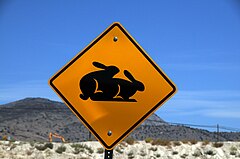unpa
 | |
| Pronunciation | /ˈun |
|---|---|
| Usage | 2023: Core (98% ↗︎ )2022: Core (97%) |
| Book and era | nimi pu |
| Part of speech | Content word |
| Codepoint | U+F196F |
unpa is a core content word relating to sexual intercourse.
Etymology[edit | edit source]
The word unpa is possibly derived from an onomatopeia for humping.[1][2]
Semantic space[edit | edit source]
The semantic space of unpa includes the act or an instance of sexual intercouse, regardless of the number, gender, or biological sex of the participants. As such, masturbation may also be described as such.[3]
sina wile ala wile unpa e misina wile ala wile unpa e mi?
Do you want to have sex with me?
unpa li pona tawa miunpa li pona tawa mi.
I like sex / I enjoy having sex.
Its semantic space includes sexual reproduction, including non-animal reproduction, as in pollination;[4] and to some extent, asexual reproduction, such as mitosis.[5] These senses are overlap with the space of mama.
tenpo unpa la soweli mije li utala.tenpo unpa la soweli mije li utala.
In the breeding season, the male animals fight.
unpa can refer to other intimate relations, but they are framed as either part of sex or in their relationship to sex.
pu[edit | edit source]
In the "Official Toki Pona Dictionary" section, the book Toki Pona: The Language of Good defines unpa as:
VERB to have sexual or marital relations with
The phrasing of the definition has led some people to believe that unpa has to do with marriage. However, this is not the case. The phrase to have marital relations is an euphemism for having sex, typically between marital partners.
ku[edit | edit source]
For Toki Pona Dictionary, respondents in ma pona pi toki pona translated these English words as unpa:[6]
sex5, sexual5, sexually5, fucking3, fuck2
sitelen pona[edit | edit source]
The sitelen pona glyph for unpa () is a curve shaped like a symmetrical trefoil knot, with one lobe pointing down. Common interpretations include the penis, the vagina, and a depiction of penetrative intercourse. In jan Sonja's handwriting, it also resembles the combination of the glyphs for pilin and palisa.
Some people write this symbol in an alternative way, which looks like a three-set Venn diagram.[citation needed]
sitelen sitelen[edit | edit source]
See also[edit | edit source]
References[edit | edit source]
- ↑ "Word Origins". tokipona.org. Archived from the original on 8 August 2002.
- ↑ jan Sonja [@sonjalang]. (6 February 2024). [Message posted in the
#pana-sonachannel in the ma pona pi toki pona Discord server]. Discord. "i assumed it came from the english word oomph". - ↑ lipamanka. "toki pona dictionary". lipamanka.gay.
- ↑ jan Koko [@never_rare]. (27 September 2023). [Informal poll posted in the
#sona-kulupuchannel in the ma pona pi toki pona Discord server]. Discord. Retrieved 11 October 2023. "pollination is unpa".Is pollination included in the semantic space of unpa? Option Votes Yes 80 No 16 I don't know 15 Other answer 2 - ↑ palisa jelo Natan [@bananatreelabs]. (27 September 2023). [Informal poll posted in the
#sona-kulupuchannel in the ma pona pi toki pona Discord server]. Discord. Retrieved 11 October 2023. "nimi unpa la do you think of the creation of an organism sin, the exchange of genetics/traits, or the intimacy as most relevant? […] [Multiple answers, up to 2 out of the first 3, are allowed]".Which of the following options are the most relevant to the semantic space of unpa? Option Votes Creation of a new organism is most important 6 Exchange of genetic traits is most important 4 Intimacy is most important 66 None of the above are most important 19 Something else is more important 2 - ↑ Lang, Sonja. (18 July 2021). Toki Pona Dictionary. Illustrated by Vacon Sartirani. Tawhid. ISBN 978-0978292362. p. 381.
Further reading[edit | edit source]
- "unpa" on lipu Linku
- "unpa" on lipu Wikipesija
- "unpa" on English Wiktionary
